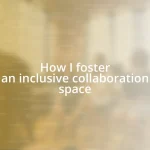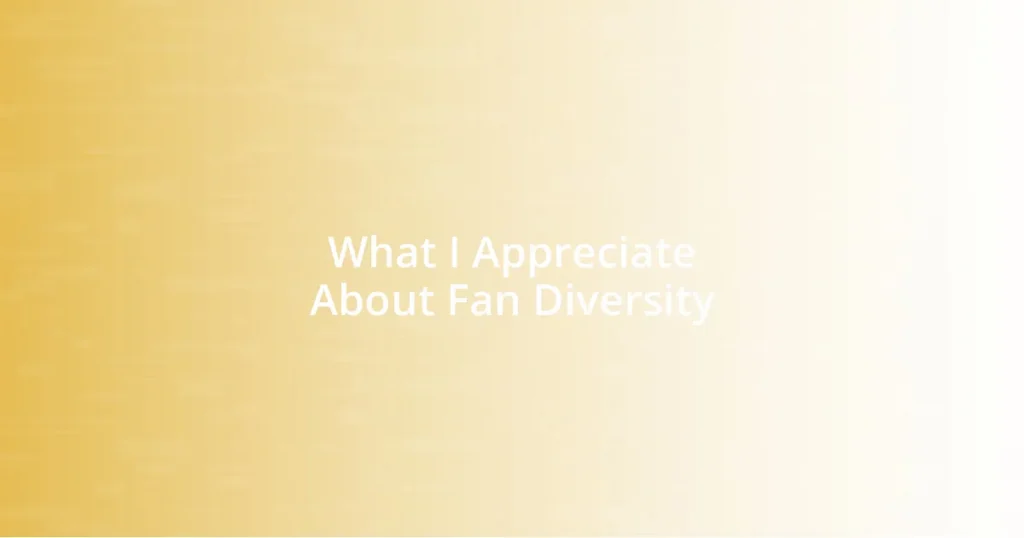Key takeaways:
- Collaboration enhances creativity and fosters a sense of belonging among team members.
- Key traits of collaborative team members include open communication, adaptability, and emotional intelligence.
- Setting clear communication guidelines and encouraging open feedback loops significantly improve teamwork dynamics.
- Recognizing and rewarding collaborative efforts increases motivation and strengthens team bonds.

Understanding the importance of collaboration
Collaboration is essential in any work environment because it brings diverse perspectives together. I remember a particular project where our team was stuck on a daunting problem. It was fascinating to see how, by simply sharing our individual insights and experiences, we unlocked solutions that none of us would have found alone. Have you ever felt that moment when everything clicks because someone voiced an idea you hadn’t considered?
When people collaborate, the synergy often leads to heightened creativity and innovation. I’ve experienced this firsthand in brainstorming sessions where the energy in the room shifted, and ideas flowed more freely as we built on each other’s thoughts. It makes me wonder—how often do we miss out on brilliant ideas simply because we work in isolation?
Moreover, nurturing a collaborative spirit fosters a sense of belonging and strengthens team bonds. There were times when I felt isolated in a crowded open office, but after a few team-building activities, everything changed. The laughter and shared experiences created a foundation of trust that transformed our work dynamics. Doesn’t it feel empowering to know that, together, we can achieve so much more than we ever could alone?

Identifying collaborative team members
Identifying collaborative team members requires a keen sense of observation and intuition. I often look for those individuals who naturally gravitate toward teamwork, demonstrating open communication and active listening. In my experience, I’ve found that team members who frequently ask questions and show genuine curiosity about others’ perspectives tend to be more collaborative. When I notice someone encouraging input in meetings, I can’t help but think—this person is a true team player.
Another trait I value is adaptability. In previous projects, I had teammates who could pivot when plans changed suddenly, maintaining a positive attitude. This flexibility not only enhances collaboration but also creates an environment where others feel comfortable sharing their ideas without fear of judgment. Have you ever worked with someone who was resistant to change? Those encounters remind me of how essential it is to identify team members who embrace new challenges together.
Lastly, I pay attention to emotional intelligence. Team members who recognize and respond to the emotions of others contribute greatly to a collaborative atmosphere. I recall an instance where one of my colleagues noticed that a teammate was overwhelmed and offered support, which ultimately led to a significant breakthrough in our project. It just goes to show that empathy in the workplace isn’t just nice to have—it’s crucial for fostering collaboration.
| Traits of Collaborative Team Members | Indicators |
|---|---|
| Open Communication | Encourages others to share ideas |
| Adaptability | Pivots easily to new challenges and fosters a positive work environment |
| Emotional Intelligence | Recognizes and responds to teammates’ feelings |

Setting clear communication guidelines
One of the most effective ways I’ve found to foster collaboration is by setting clear communication guidelines. When everyone understands the expectations around how we share information, it creates a strong foundation for teamwork. I remember in a project where we established a rule that all feedback should be constructive and specific. This small change made a huge difference—suddenly, conversations felt more supportive and productive.
- Encourage open dialogue: Let everyone feel comfortable sharing their thoughts without fear of criticism.
- Be specific in feedback: This helps to avoid misunderstandings and promotes clarity.
- Utilize available communication tools: Choose tools that suit your team’s needs, whether it’s email, messaging apps, or project management software.
- Establish regular check-ins: This keeps everyone aligned and allows for real-time adjustments.
Additionally, I make it a point to emphasize active listening. In one particularly tense meeting, I noticed a colleague’s frustration. By practicing active listening, I encouraged everyone to paraphrase what had been said before responding. This not only validated their concerns but also created a sense of unity among the team. When people feel heard, the energy shifts positively, paving the way for better collaboration.

Encouraging open feedback loops
Encouraging open feedback loops is vital for nurturing collaboration. I’ve learned that creating opportunities for team members to freely share their thoughts can really enhance our working relationships. For instance, during a recent project, I initiated a weekly feedback session. Instead of just waiting for formal reviews, this informal space allowed everyone to voice their ideas and concerns in a relaxed setting. It was eye-opening to see how much creativity flowed when the pressure of formal settings was lifted.
Have you ever witnessed a team transform just from a simple change in how feedback is approached? I vividly recall an instance where, after implementing a practice of giving regular, informal feedback, the atmosphere shifted dramatically. Colleagues started engaging more openly, and ideas began bouncing around like a lively game of ping-pong. It was exhilarating to feel that momentum build, knowing we were all contributing to each other’s growth.
When I encourage open feedback, I often remind everyone that it’s not about judgment but growth. During one project, I had a team member who was hesitant to express their thoughts. I shared my own early experiences of feeling intimidated in meetings. That personal touch seemed to resonate with them, and soon they began contributing brave ideas that took our project to new heights. It’s those moments of vulnerability that can bridge gaps and spark innovation—it really shows how far we can go when we feel safe to speak up.

Implementing team-building activities
Implementing team-building activities can be a game changer for enhancing collaboration. I once organized a fun escape room challenge for my team, and the experience was not just entertaining—it revealed so much about each person’s strengths. Watching everyone naturally fall into roles based on their skills opened my eyes to how we all can contribute uniquely when we work together toward a common goal.
Have you ever participated in team-building exercises that felt forced or cliché? I certainly have, and they often fall flat. That’s why I believe in choosing activities that resonate with the team’s interests. For example, I introduced a monthly team “lunch and learn” session, where we share not only work-related knowledge but also personal passions, like a team member’s love for photography or gardening. This simple shift brought us closer, creating bonds that extend beyond our daily tasks.
I know that trust plays a huge role in effective teamwork. One memorable team-building activity we did involved trust falls—although it was nerve-wracking for some, it allowed us to laugh, support each other, and build a sense of safety. Seeing team members catch one another made me realize how important it is to foster an environment where everyone supports one another, both in and out of the office. When team members trust each other, collaboration becomes so much more natural and fluid.

Recognizing and rewarding collaboration
Recognizing and rewarding collaboration is an essential element in fostering a collaborative culture. I remember a specific time when I acknowledged a team’s effort after a successful project. Instead of just sending out a generic email, I decided to shout out individual contributions during our all-hands meeting. The smiles on their faces were priceless, and I could see how much that genuine recognition meant to them—it turned a good team effort into something truly celebratory.
Have you ever thought about how impactful a simple thank-you can be? In one project, I set up a small rewards system for collaborative efforts. When a team member went above and beyond to assist others, they would receive a fun badge, which could later be exchanged for a coffee or lunch treat. The level of enthusiasm skyrocketed as more people strived to earn those badges, fostering a sense of teamwork. In my experience, tangible recognition sparks a competitive spirit that inspires even greater collaboration.
Creating a culture of recognition doesn’t always have to be elaborate. I’ve found that even small gestures go a long way. Once, after a critical deadline, I surprised my team with a handwritten thank-you note for their hard work. The surprise sparked discussions about appreciation and made everyone feel valued. It taught me that recognition doesn’t need to be grand; sometimes, it’s those authentic, personal touches that truly resonate and empower teams to collaborate more openly in the future.

Measuring collaboration effectiveness
Measuring collaboration effectiveness can sometimes feel elusive, but I find that using specific metrics makes it clearer. One approach I used involved creating a feedback loop where team members could evaluate their collaborative interactions. After a project wrapped up, I would distribute a survey asking things like, “Did you feel supported by your colleagues?” and “How would you rate the overall team communication?” The honest responses not only highlighted our strengths but also pinpointed areas for improvement—critical for ongoing development.
I also believe in using qualitative assessments, coupled with the traditional metrics. For instance, during one of my projects, I took the time to sit down with each team member for a reflective conversation about their experiences. Listening to their insights was enlightening; some felt unheard at times, while others relished the seamless communication. These discussions helped me gauge the real impact of our collective efforts and brought to light the importance of each voice in the collaboration process.
Have you ever thought about how to capture the intangible aspects of teamwork? To me, it’s essential to observe how team members interact informally. I pay attention to the energy during casual chats or brainstorming sessions. When I see people excitedly bouncing ideas off each other, I know we’re on the right track. Moments like those affirm that collaboration isn’t just about tasks completed, but about the connections built and the shared enthusiasm that drives us forward.















